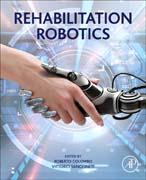
Rehabilitation Robotics gives an introduction and overview of all areas of rehabilitation robotics, perfect for anyone coming to this field for the first time. It also provides specific information about the robot technologies available and their application to different pathologies for skilled researchers and clinicians. The editors have been involved in the development and application of robotic devices for neurorehabilitation for more than 15 years. This experience, which includes the application of several commercial devices for robotic rehabilitation, has enabled them to develop the know-how (including awareness of the limitations of present robot technologies) and the expertise necessary to guide those who wish to obtain a comprehensive understanding of this topic. Each chapter is written by an expert in that field, pulling in perspectives from both engineers and clinicians to present a multi-disciplinary view. Rehabilitation Robotics aims at the implementation of efficient robot strategies to facilitate the re-acquisition of motor skills. This technology incorporates the outcomes of behavioral studies on motor learning and its neural correlates into the design, implementation, and validation of robot agents that behave as 'optimal' trainers, efficiently exploiting the structure and plasticity of the human sensorimotor systems. In this context, human-robot interaction plays a paramount role, at both the physical and cognitive level, towards achieving a symbiotic interaction where the human body and the robot can benefit from each other's dynamics. Provides comprehensive review of recent developments in the area of rehabilitation roboticsIncludes information on both therapeutic and assistive robotsFocuses on the state of the art and representative advancements in the design, control, analysis, implementation, and validation of rehabilitation robotic systems INDICE: 1. Physiological basis of neuromotor recovery 2. Computational motor control aspects in rehabilitation 3. Mechanical design of rehabilitation robots: Design of the robot structure and mechanics, including both exoskeleton and endpoint robots 4. Actuators and sensors for rehabilitation and prosthetic robots: Overview of the different actuators and sensors available and related selection criteria 5. Software platforms for integrating robots and virtual environments: Review of available development environments for rehabilitation robots 6. User-centered design of assistive and rehabilitation robots: Design approaches for robot systems that interact physically with humans for rehabilitation purposes 7. Robot control architectures: Admittance control, impedance control, adaptive regulation of assistance 8. Different forms of robot assistance for neurorehabilitation 9. Myoelectric controllers and EMG-based treatment: How to use EMG activity to detect intentions, control prostheses and shape treatment 10. Prosthetic robotic legs: Prostheses for lower-limb amputees 11. Prosthetic robotic hands: Prostheses for hand amputees, including myoelectric control 12. Robots for cognitive rehabilitation: Companion and pet robots (including humanoids ) 13. Vision for rehabilitation robots: Vision allows robots to collect more information on user and environments than just interaction forces 14. Health technology assessment and rehabilitation technologies: Applications 15. Twenty years of application of the MIT-MANUS robot 16. Three-dimensional, task-specific robot therapy 17. Bimanual training for the rehabilitation of stroke patients 18. Robot-assisted therapy of hand function 19. Exoskeletons for upper limb rehabilitation 20. Robot-assisted gait training using the Lokomat gait orthosis 21. Robot-assisted rehabilitation in multiple sclerosis 22. Robot therapy in children with cerebral palsy 23. Increasing motivation during robot-assisted rehabilitation 24. Wearable robotic applications for neurorehabilitation 25. Hybrid FES-robot devices for training of activities of daily living 26. Use of robot devices for the assessment of motor function 27. Robotic techniques for evaluation and training of proprioceptive deficits 28. Parametric identification techniques for the assessment of motor recovery 29. Use of robot devices for tremor suppression 30. Neural and muscular correlates of robot-assisted rehabilitation 31. The role of muscle synergies in robot-assisted neurorehabilitation 32. Integration of robot-assisted rehabilitation and non-invasive brain stimulation 33. Telerehabilitation training program for hand therapy in stroke: Experience with the Hand Mentor device
- ISBN: 978-0-12-811995-2
- Editorial: Academic Press
- Encuadernacion: Rústica
- Páginas: 380
- Fecha Publicación: 01/11/2017
- Nº Volúmenes: 1
- Idioma: Inglés
